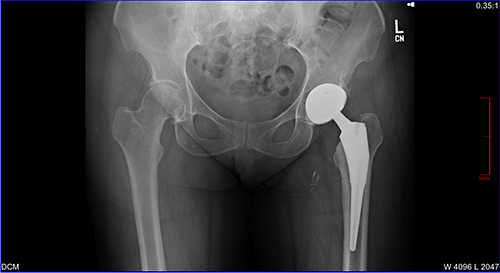Total Hip Replacement
Total hip replacement is a surgical procedure in which the damaged cartilage and bone is removed from the hip joint and replaced with artificial components. The hip joint is one of the body’s largest weight-bearing joints, located between the thigh bone (femur) and the pelvis (acetabulum). It is a ball and socket joint in which the head of the femur is the ball and the pelvic acetabulum forms the socket. The joint surface is covered by a smooth articular cartilage which acts as a cushion and enables smooth movements of the joint.

A number of diseases and conditions can cause damage to the articular cartilage. Total hip replacement surgery is an option to relieve severe arthritis pain that limits your daily activities.
Total hip replacement may be recommended, if conservative treatment options such as anti-inflammatory medications and physical therapy do not relieve the symptoms.
Procedure
The surgery is performed under Spinal or general anesthesia. During the procedure a surgical cut is made over the hip to expose the hip joint and the femur is dislocated from the acetabulum. The surface of the socket is cleaned and the damaged or arthritic bone is removed using a reamer. The acetabular component is inserted into the socket using press fit or screws. A liner made of plastic, ceramic or metal is placed inside the acetabular component. The femur or thigh bone is then prepared by removing the arthritic bone using special instruments, to exactly fit the new metal femoral component.
The femoral component is then inserted to the femur by a press fit. Then the femoral head component made of metal or ceramic is placed on the femoral stem. The muscles and tendons around the new joint are repaired and the incision is closed.
Post-operative care
After undergoing an anterior total hip replacement, pain will be your guide. You will be using a rolling walker for 1-2 weeks until you feel comfortable without it. Your surgeon will tell you when you may resume specific activities at your 2-week and 6 week appointments.
Risks
As with any major surgical procedure, there are certain potential risks and complications involved with total hip replacement surgery. The possible complications after total hip replacement include:
- Infection
- Dislocation
- Fracture of the femur or pelvis
- Injury to nerves or blood vessels
- Formation of blood clots in the leg veins
- Leg length inequality
- Hip prosthesis may wear out
- Failure to relieve pain
- Scar formation
- Pressure sores
Total hip replacement is one of the most successful orthopedic procedures performed for patients with hip arthritis. This procedure can relieve pain, restore function, improve your movements at work and play, and provide you with a better quality of life.
![]() Technology Portfolio For Forever Hip Campaign 2014
Technology Portfolio For Forever Hip Campaign 2014
You will need the Adobe Reader to view and print these documents.





